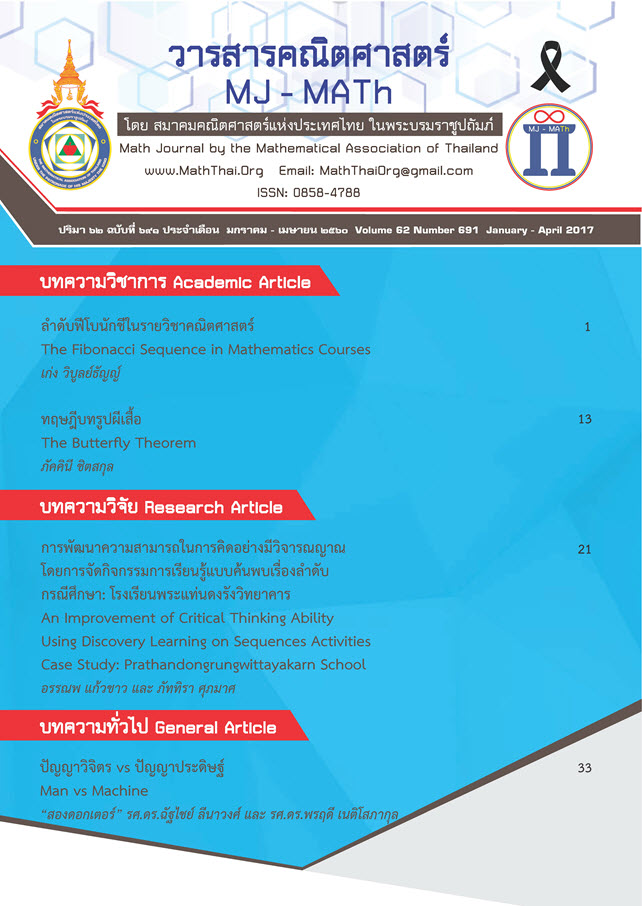An Improvement of Critical Thinking Ability Using Discovery Learning on Sequences Activities Case Study: Prathandongrungwittayakarn School
Main Article Content
Abstract
The main purposes of this research were to develop lesson plans using discovery method instruction on sequences according to efficiency criterion of 70/70. In addition, the effectiveness index of lesson plans by discovery method on sequences was studied. In this regard, the comparison of ability of critical thinking between before learning and after learning by the discovery activities was performed. The sample of this study is a group of 35 students of Matthayomsuksa 6 at Prathandongrungwittayakarn School, in the first semester of the 2 0 1 6 academic year. The results revealed that (1) the efficiency of the lesson plans by discovery method instruction on sequences for Matthayomsuksa 6 met the standard criterion of 74.86/71.05, (2) the effectiveness index of mathematics lesson plans by using discovery method on sequences is at 0.6108 (3) the overall critical thinking of Matthayomsuksa 6 students after learning discovery activities is significantly higher than before leaning at the 0.01 level.
Article Details
References
[2] บุบผา เมฆศรีทองคำ , “การรู้เท่าทันสื่อ: การก้าวทันบนโลกข่าวสาร,” วารสารนักบริหาร, ปีที่ 31, ฉบับที่ 1, pp. 117-123, 2554.
B. Makesrithongkum, “Media Literacy: Keeping Pace with Information Age,” Executive Journal, vol. 31, no. 1, pp. 117-123, 2011 (in Thai).
[3] พิมพันธ์ เดชะคุปต์, และพเยาว์ ยินดีสุข, การจัดการเรียนรู้ในศตวรรษที่ 21, กทม: โรงพิมพ์แห่งจุฬาลงกรณ์มหาวิทยาลัย, 2558.
P. Dachakupt, and P. Yindeesuk, The 21st Century Learning, Bangkok: Chulalongkorn University Printing house, 2015 (in Thai).
[4] ศราวุธ จอมนำ, “ผลการเรียนรู้โดยใช้บริบทเป็นพื้นฐาน เรื่องอัตราส่วนและร้อยละ ที่มีต่อผลสัมฤทธิ์ทางการเรียนวิชา คณิตศาสตร์ ความสามารถในการคิดอย่างมี วิจารณญาณและคุณลักษณะใฝ่เรียนรู้ของนักเรียนชั้นมัธยมศึกษาปีที่ 2,” ปริญญา นิพนธ์การศึกษามหาบัณฑิต, มหาวิทยาลัยศรีนครินทรวิโรฒ, กทม, 2557.
S. Jomnum, “The Effects of Context-Based Learning about the Ratio and Percentage on Mathematical Achievement, Critical Thinking Ability and Learning Curiosity of mathayomsuksa II Students,” Master’s Thesis M.Ed. (Secondary Education), Srinakharinwirot University, Bangkok, 2014 (in Thai).
[5] ประพันธ์ศิริ สุเสารัจ, การพัฒนาการคิด, กทม: โรงพิมพ์ห้างหุ้นส่วนจำกัด 9119 เทคนิคพริ้นติ้ง, 2551.
P. Susaorat, Thinking Development, Bangkok: 9119 Technic Printing Limited Partnership, 2551 (in Thai).
[6] Boss. Judith A, Think: Critical Thinking and Logic Skill for Everyday Life, New York: McGraw-Hill Companies Inc., 2010.
[7] สุพรรณี คำนันท์, “ผลของการเรียนแบบผสมผสานโดยใช้แนวคิดการเรียนรู้แบบค้นพบด้วยวิธีอุปนัยและนิรนัยที่มีต่อการรับรู้ความสามารถของตนเองในวิชา คณิตศาสตร์ ของนักเรียนชั้นมัธยมศึกษาปีที่ 3 ที่มีระดับความสามารถทาง คณิตศาสตร์แตกต่างกัน,” วิทยานิพนธ์ปริญญาครุศาสตร์มหาบัณฑิต, จฬุาลงกรณ์มหาวิทยาลัย, กทม, 2552.
S. Khamnan, “Effects of blended learning with discovery learning approach using inductive and deductive methods upon self-efficacy in mathematics
subjects of ninth grade students with different mathematics learning ability levels,” Master’s Thesis M.Ed. (Audio-Visual Communications), Chulalongkorn University, Bangkok, 2009 (in Thai).
[8] A. Sokolowski and R. Rackley, “Teaching harmonic motion in trigonometry: Inductive inquiry supported by physics simulations,” Australian Senior Mathematics Journal, vol. 25, no. 1, pp. 45-53, 2011.
[9] สุวพิชชา ประสิทธิธัญกิจ, “การศึกษาการคิดอย่างมีวิจารณญาณของนักเรียนในระดับชั้นมัธยมศึกษาตอนปลาย โรงเรียนสาธิตมหาวิทยาลัยรามคำแหง,” วารสารมหาวิทยาลัยรามคำแหง, ปีที่ 8, ฉบบัที่ 1, pp. 102-117, 2548 S. Prasitithunyakit, “A Student on Critical Thinking of the Upper Secondary School Students at the Demonstration School of Ramkhamhaeng University,” Ramkhamhaeng Journal, vol. 8, no.1, pp. 102-117, 2011 (in Thai).


